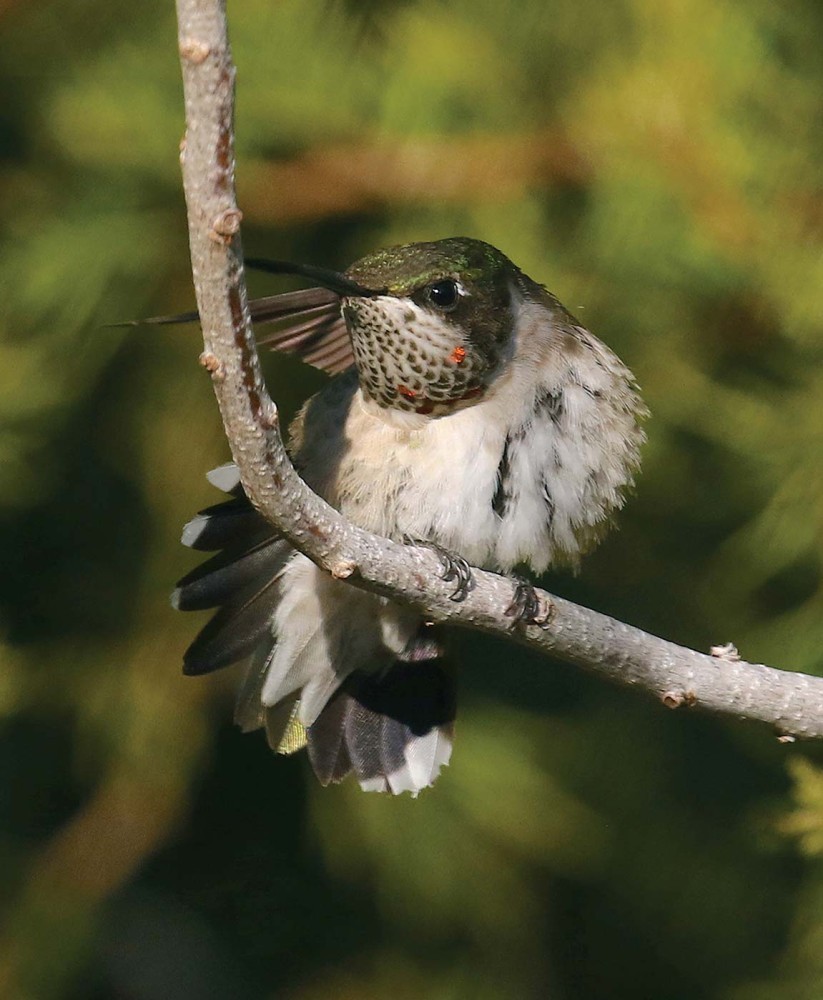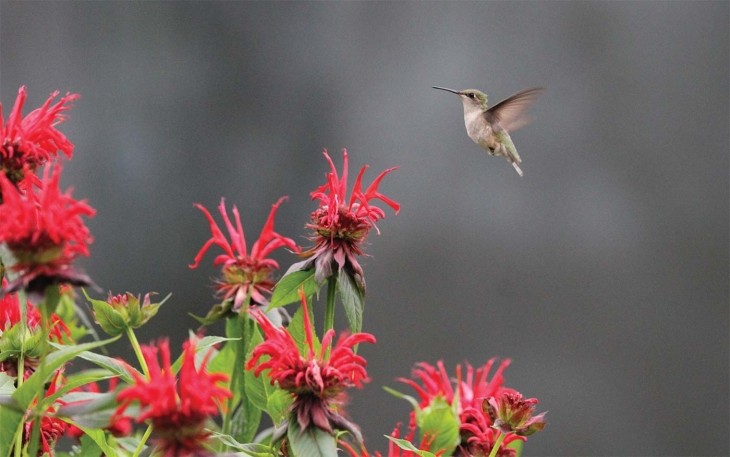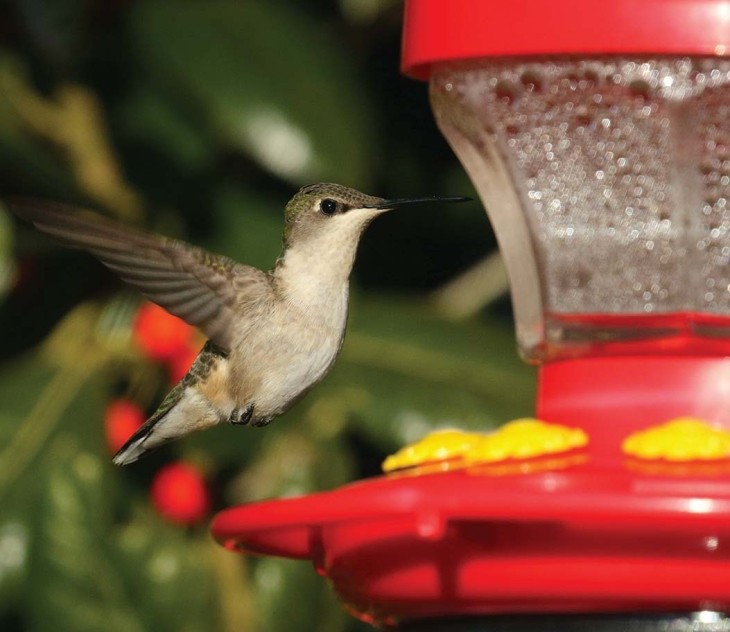
The ruby-throated hummingbird (Archilochus colubris) is a favorite among birdwatchers in backyards and gardens, where these tiny, brightly colored birds whir from flower to flower and visit feeders filled with sugar water. This is the only hummingbird species that breeds in eastern North America, with a range extending from the Mississippi River east throughout the Midwest, and from southern Canada to Florida.
Most ruby-throated hummingbirds spend winters in southern Mexico and Central America, with smaller numbers overwintering in southern to central Florida. Studies during the past several decades, however, indicate ruby-throats are arriving on breeding grounds earlier in the spring and lingering later in the fall. Some birds are eschewing migration altogether to remain farther north through the winter. During the last two decades, ruby-throats have overwintered in Georgia, South Carolina, North Carolina, and Virginia. And in the last 10 years, some have remained through the winter even farther north.
This northward-creeping trend suggests ruby-throated hummingbirds may eventually spend winters in Pennsylvania, New York – and perhaps even in New England. In the winter of 2019–2020, one immature female ruby-throat was observed in Cape May, New Jersey, according to data recorded on eBird, a citizen-scientist birding website and application designed by the Cornell Lab of Ornithology. During this past winter, at least two more ruby-throated hummingbirds – an immature female and male – spent the winter along the cape.
Reasons for this gradual northward shift may include increasingly mild winters, growing availability of hummingbird feeders, and intensifying storm seasons around the Gulf of Mexico, which many ruby-throats cross during migration.
A Fast-paced Life
Ruby-throated hummingbirds are miniscule, weighing 2 to 6 grams, with a wingspan of 3 to 4 inches. What they lack in size, however, they make up for in resourcefulness. Skilled fliers, they can move forward and backward and are able to hover in the air. With wings that beat at a rate of more than 50 times a second, the ruby-throat is able to zip through the various habitats found across its breeding range, from Florida’s subtropical forests to the boreal forests of Canada.
In order to sustain such a swift pace of life, ruby-throats must consume a high-energy diet. This consists largely of nectar from seasonally flowering plants. They readily eat from backyard feeders and also consume sap from evergreen and cedar trees, insects such as fruit flies and gnats, and even small spiders.
Hummingbirds typically leave southern wintering territories in March to make the hazardous journey north. Backyard birding enthusiasts may begin to see hummingbirds arrive in early April in the southern states and by the end of April or beginning of May in the mid-Atlantic and New England states. Our Canadian neighbors can expect ruby-throats to return by the middle of May.
Male ruby-throats arrive before females to claim territories and to entice prospective mates when they arrive later in spring. Females do nearly all the work involved in identifying a nest site and building the nest. A hummingbird nest is just 2 inches across and 1 inch deep, but incredibly strong and flexible due to the use of spiderweb silk woven with thistle or dandelion down into a cup.
Male ruby-throats will often mate with several different females in a single breeding season, and females rear offspring solo. Each clutch contains two to three eggs. Female ruby-throats will also find a second mate, if resources and time allow, to lay a second clutch of eggs by early summer. Once late September hits, ruby-throated hummingbirds go into migration mode and start packing on extra grams of fat for the journey south.
Migratory Risks
Migration can be a treacherous undertaking. Some ruby-throats must travel thousands of miles from their breeding grounds to traditional wintering areas. For many, this includes crossing a 500-mile span of the Gulf of Mexico, although recent research suggests the majority of ruby-throats opt for overland routes to circumnavigate the Gulf during fall migration. The entire migratory journey can last about two weeks.
For those that do cross the Gulf, the over-water journey takes about 22 hours, which the birds must do without stopping, unless they find an oil rig on which to rest. Hummingbirds cannot swim, and strong winds and high waves spell a quick demise at sea for countless ruby-throated hummingbirds each year. To further complicate the process, the autumn migration period for ruby-throats coincides with peak hurricane season in and near the Gulf.
Successful Overwintering in the Mid-Atlantic
A small percentage of the population chooses to skip traveling to Mexico and Central America, instead overwintering in southern Florida and along the Gulf Coast. In migratory species, individual birds that overwinter typically do so only if they are sick or injured – or if the potential rewards of staying outweigh the risks of migrating.
In the case of ruby-throats, adequate food resources – including hummingbird feeders hung in yards – in parts of their breeding range may be enticing some birds to remain in the United States year-round. This includes younger ruby-throated hummingbirds that are more likely to migrate south from Canada and New England and overwinter in the mid-Atlantic and southeastern United States because of their lack of previous migratory experience in going farther south.
Several studies have indicated a shift in the migratory habits for ruby-throated hummingbirds along the East Coast. These include a study by Doreen Cubie in 2014, which documented ruby-throated hummingbirds wintering along the southeastern Atlantic coast during the prior 25 years. Cubie’s research suggests it is typical of hatch-year males and females to overwinter in the southeastern states of Georgia and South Carolina. This, coupled with increasing eBird observations in states from North Carolina to New Jersey, may indicate that ruby-throats of various ages are migrating from Canada and New England during the fall and remaining in the mid-Atlantic and southeast for the duration of winter.
In Massachusetts, one study based on community-science observations during the span of 32 years – from 1970 through 2002 – found the migratory window for ruby-throated hummingbirds was expanding, specifically in spring. The study concluded that ruby-throats arrived in breeding grounds roughly 18 days earlier in 2002 than they had in 1970. That trend has continued in the years since the study.
Another study conducted at Hawk Mountain Sanctuary in eastern Pennsylvania between 1990 and 2014 found the ruby-throated hummingbird population increased 2 percent annually from 1955 through 2013 in New England and the mid-Atlantic. Audubon’s annual Christmas Bird Count also shows a steady increase in ruby-throat numbers from 1990 to 2014. Increased competition within the ruby-throat population, due to this increase in overall numbers, could explain the shift in migratory habits in some members of the species.
Operation RubyThroat, a nonprofit that studies the wintering habits of hummingbirds along the Atlantic coast, tracks all winter sightings. Data collected by the group suggests that most wintering ruby-throats, as well as other hummingbird vagrants, are immature or hatch-year birds. The female hummingbird in Cape May in the winter of 2020 was an immature female and had never made the migratory journey south before. Altogether, Operation RubyThroat and eBird data collected in New Jersey from 2019 to 2021 show at least two and possibly three younger ruby-throats surviving there during this past winter.
Forging New Territory
This expansion of new winter territory comes with new dangers for ruby-throated hummingbirds in the mid-Atlantic and New England states, as they are not adapted to survive extended periods of cold weather and snow. Hummingbirds can slow their heartbeat in order to conserve energy when sleeping or when temperatures drop, entering a state of torpor during the night or during adverse weather conditions. But ruby-throats would need an abundant natural energy resource to successfully survive winter in the Northeast past November. A span of several winters with huge snow accumulations and freezing temperatures would likely push many ruby-throats to migrate or perish.
Fans of these colorful birds may be happy to learn that eBird observations during the past decade show individual ruby-throated hummingbirds staying along the coast of Massachusetts’ Cape Cod well into December in some years. In New Jersey, Cape May Point’s overwintering ruby-throats may be outliers of their species – or a sign of things to come.



